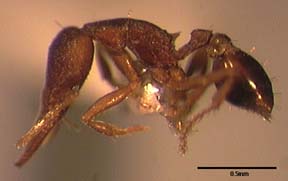Neostruma myllorhapha Brown 1959
Formicidae, Hymenoptera, Insecta, Arthropoda, Animalia

Specimen: Costa Rica, Prov. Heredia: La Selva, JTL1391-s, INBIOCRI001283815. Image by J. Longino. 
Specimen: Costa Rica, Prov. Puntarenas: Monteverde, JTL6Feb82/1617, INBIOCRI001283820. Image by J. Longino. |

Specimen: Costa Rica, Prov. Heredia: La Selva, JTL1391-s, INBIOCRI001283815. Image by J. Longino. |
Identification
Middle preapical denticle of mandible distinctly larger than flanking denticles, similar in size to basal denticle; mesosomal dorsum evenly convex, propodeal suture not impressed; total head length > 0.90mm.
Specimens from the lowlands are light ferrugineous and relatively smaller, while those from montane regions are dark brown and relatively larger (see discussion of montane dark forms). In the case of N. myllorhapha I have been able to detect neither morphological discontinuity between light and dark forms, nor zones of sympatry. Therefore I treat the light and dark forms as intraspecific variation in this case.
Range
Costa Rica (Atlantic slope to 1600m).
Natural History
Brown (1959) characterizes the genus as a whole as forming
"small colonies, chiefly in the leaf litter of rain forest or tropical evergreen forest, and nests occupy cavities in rotting twigs, pieces of bark or similar forest-floor vegetable debris... The food... consists primarily of small entomobryomorph Collembola and possibly some other minute terrestrial arthropods as well. Hunting behavior is like that of Smithistruma rather than like the Strumigenys so far studied."
This species inhabits wet forested habitats from lowland rainforest to cloud forest. It occurs commonly in leaf litter on the forest floor but may occur in the canopy under epiphytes. Nests are known from in or under dead wood on ground.
Selected Records
Winkler samples from Hitoy Cerere, Rara Avis, Braulio Carrillo National Park to 1200m, La Selva, Penas Blancas Valley, Monteverde cloud forest, Guanacaste Conservation Area (Cerro Cacao, Pitilla).
Braulio Carrillo (Bajo La Hondura): nest in 1cm dia hollow stem of a freshly fallen canopy branch. No brood inside, only workers.
Monteverde: in Winkler sample of epiphytes and arboreal soil taken in canopy of emergent tree, 15m high.
Monteverde: nest under board in "Bull Pen" (a small pasture surrounded by cloud forest).
Penas Blancas (800m): nest in dead stick on ground.
Literature Cited
Brown, W. L., Jr. 1959. A revision of the Dacetine ant genus Neostruma. Breviora 107:1-13.
John T. Longino, The Evergreen State College, Olympia WA 98505
USA.
longinoj@evergreen.edu
Last modified: 10 June 1997


